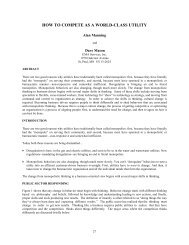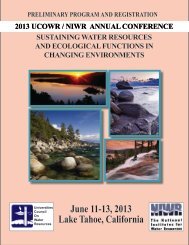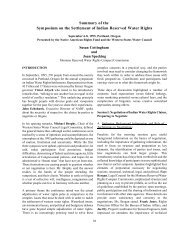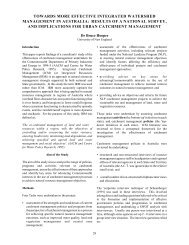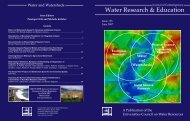114Bourget4.management, drought management, flood risk <strong>and</strong>system reliability, floodplain management, publicparticipation, environmental impact analysis, aquaticecosystems, water resources economics, waterresources engineering, water conservation, watershedplanning, social/cultural/behavioral issues, ethics <strong>of</strong>water resources, flood damage reduction/storm watermanagement, urban supply <strong>and</strong> sanitation, watershedmanagement, <strong>and</strong> other.The education/training disciplines that were providedwere: civil engineering, watershed hydrology/modeling,biology/life sciences, water chemistry,geology, microbiology, law/regulatory,GIS/geography, soils/agronomy, economics, publicpolicy, statistics, meteorology, forest/rangel<strong>and</strong>management.Author Bio <strong>and</strong> Contact InformationPAUL G. BOURGET (Ph.D) is Program Manager forthe Advanced Degree Program in Integrated <strong>Water</strong>Resources Management at the U.S. Army Corps <strong>of</strong>Engineers’ Institute for <strong>Water</strong> Resources. He is also anadjunct pr<strong>of</strong>essor at the George Washington University’sInstitute for Crisis, Disaster <strong>and</strong> Risk Management. Hecan be contacted at paul.g.bourget@iwr01.usace.army.mil.ReferencesU.S. Army Corps <strong>of</strong> Engineers. 2001. Civil WorksPlanner Capability Task Force Report (Training<strong>and</strong> Development). Institute for <strong>Water</strong> Resources;Alex<strong>and</strong>ria, Virginia.Universities Council on <strong>Water</strong> Resources. 2001.Development <strong>of</strong> a Curriculum for a Masters DegreeProgram in <strong>Water</strong> Resources Planning. Institute for<strong>Water</strong> Resources; Alex<strong>and</strong>ria, Virginia.UCOWRJOURNAL OF CONTEMPORARY WATER RESEARCH & EDUCATION
115UNIVERSITIES COUNCIL ON WATER RESOURCESJOURNAL OF CONTEMPORARY WATER RESEARCH & EDUCATIONISSUE 135, PAGES 115-130, DECEMBER 2006<strong>Issue</strong>s for CEOs <strong>of</strong> <strong>Water</strong> Utilities with theImplementation <strong>of</strong> Australian <strong>Water</strong> LawsJennifer McKayDirector, Center for Comparative <strong>Water</strong> Policies <strong>and</strong> LawsUniversity <strong>of</strong> South AustraliaThe Australian Government has embarked ontwo phases <strong>of</strong> ambitious reform <strong>of</strong> state laws<strong>and</strong> policies for water management. Thefirst in 1994 was known as Council <strong>of</strong> AustralianGovernment reforms (CoAG) <strong>and</strong> the second in2004 is known as the National <strong>Water</strong> Initiativereforms. These were prompted by a number <strong>of</strong>domestic environmental <strong>and</strong> social issues <strong>and</strong>international processes targeted at reducinggovernment activity in water management. The firstset required massive changes to water governancethat is separating functions into environmental,economic, <strong>and</strong> water supplier <strong>and</strong> also requiringEnvironmentally Sustainable Development (ESD)<strong>and</strong> integration in all water development proposals.The second phase extends the first but is much moreprescriptive <strong>and</strong> sets out 80 goals that water supplybusinesses <strong>and</strong> state governments must encouragerural <strong>and</strong> urban communities to achieve.This paper presents empirical data <strong>of</strong> the results<strong>of</strong> telephone interviews with 183 Chief ExecutiveOfficers <strong>of</strong> the major water supply businesses inAustralia. These respondents are highly educated<strong>and</strong> experienced business pr<strong>of</strong>essionals. Bearingthis in mind, the instrument designed for themrequired sophisticated responses to approximately100 questions about Environmentally SustainableDevelopment, integration, <strong>and</strong> other issuesabout water policy changes under CoAG <strong>and</strong> toa lesser extent the National <strong>Water</strong> Initiative. Theinterviews were conducted between late September2005 <strong>and</strong> late January 2006. This paper will reporton responses to questions about integration <strong>and</strong>Environmentally Sustainable Development inwater policy. For the Environmentally SustainableDevelopment questions, respondents weresimultaneously emailed response sets so theycould provide their view <strong>of</strong> the rank or order <strong>of</strong> thespecified issues.Paradigms in Australian <strong>Water</strong> PolicyDevelopmentAustralia has had four paradigms <strong>of</strong> formalwater resources laws <strong>and</strong> policies since 1788(Figure 1). Prior to 1788 there is evidence thatindigenous society engaged in regional sharing<strong>of</strong> parts <strong>of</strong> river <strong>and</strong> coastal systems in a complexsocial arrangement (Langdon 2002, McKay 2002a,2002b, 2003). The imposition <strong>of</strong> the legal rule <strong>of</strong>Terra Nullius from 1788 <strong>and</strong> the deeming that therewere no pre-existing laws meant that the commonlaw <strong>of</strong> Engl<strong>and</strong> was applied to the colony. Thismeant the riparian rule applied for surface water,thus limiting access to l<strong>and</strong>holders by the river.In addition, the unimpeded extraction <strong>of</strong> groundwater rule applied.Development preceded apace in Paradigm 1 <strong>and</strong>the riparian rule was replaced in each State by amore extensive water allocation system, relying onchannels <strong>and</strong> distributing water to users away fromthe main channel (Clark <strong>and</strong> Renard 1970, McKay2006). Briefly, Paradigm 1 allocated surface wateras if it would never run out <strong>and</strong> did not considersoil issues. The use <strong>of</strong> ground water was notregulated (following the common law rule). In thisParadigm, the States federated in 1901, but only onthe condition that Section 100 <strong>of</strong> the Constitutionpreserved the rights <strong>of</strong> the States to control theconservation <strong>of</strong> water <strong>and</strong> its use for irrigation.This section ensured that federal power overnavigation would be subordinate to these uses aslong as the use was reasonable. The predominantJOURNAL OF CONTEMPORARY WATER RESEARCH & EDUCATIONUCOWR
- Page 3:
Journal of ContemporaryWater Resear
- Page 6 and 7:
2Bruce Hooperinstitutional, and tem
- Page 11 and 12:
IWRM: Governance, Best Practice, an
- Page 13 and 14:
IWRM: Defi nitions and Conceptual M
- Page 15 and 16:
IWRM: Defi nitions and Conceptual M
- Page 17 and 18:
IWRM: Defi nitions and Conceptual M
- Page 19:
IWRM: Defi nitions and Conceptual M
- Page 22 and 23:
18Cardwell. Cole, Cartwright, and M
- Page 24 and 25:
20Mostert26 water boards responsibl
- Page 26 and 27:
22MostertTable 1. Third National Wa
- Page 28 and 29:
24MostertImplementationThe ambitiou
- Page 30 and 31:
26MostertBiswas, A. K. 2004b. Respo
- Page 32 and 33:
28UNIVERSITIES COUNCIL ON WATER RES
- Page 34 and 35:
30Ashton, Turton, and Rouxresource
- Page 36 and 37:
32Ashton, Turton, and Rouxassumptio
- Page 38 and 39:
34Ashton, Turton, and RouxEffective
- Page 40 and 41:
36UNIVERSITIES COUNCIL ON WATER RES
- Page 42 and 43:
38Hussey and Doversin water policy
- Page 44 and 45:
40Hussey and Dovers1994 Council of
- Page 46 and 47:
42Hussey and Doversestablished Thes
- Page 48 and 49:
44Hussey and DoversTable 1. Typolog
- Page 50 and 51:
46Hussey and Doversassessment appro
- Page 52 and 53:
48Hussey and Doverspolicy goals.Bey
- Page 54 and 55:
50Hussey and DoversFrawley, K. 1994
- Page 56 and 57:
52Mitchelloften took three to four
- Page 58 and 59:
54Mitchelltree preservation plans;
- Page 60 and 61:
56UNIVERSITIES COUNCIL ON WATER RES
- Page 62 and 63:
58Genskow and Borna series of chall
- Page 64 and 65:
60Genskow and BornTable 1. Watershe
- Page 66 and 67:
62Genskow and Bornthe first Dungene
- Page 68 and 69: 64Genskow and BornWashington, DC.Ko
- Page 70 and 71: 66Green and Fernández-BilbaoWithin
- Page 72 and 73: 68Green and Fernández-Bilbaosubjec
- Page 74 and 75: 70Green and Fernández-Bilbaoinflue
- Page 76 and 77: 72Green and Fernández-BilbaoBerbel
- Page 78 and 79: 74UNIVERSITIES COUNCIL ON WATER RES
- Page 80 and 81: 76BallweberEstablish AdvisoryCommit
- Page 82 and 83: 78Ballweberattributes in others (Ch
- Page 84 and 85: 80UNIVERSITIES COUNCIL ON WATER RES
- Page 86 and 87: 82Barreiraand ground water. To this
- Page 88 and 89: 84Barreirawith other states for int
- Page 90 and 91: 86UNIVERSITIES COUNCIL ON WATER RES
- Page 92 and 93: 88Davis and ThrelfallResource Manag
- Page 94 and 95: 90Davis and ThrelfallTable 2. Thirt
- Page 96 and 97: 92Davis and Threlfallby regional an
- Page 98 and 99: 94Davis and Threlfallenforcement, a
- Page 100 and 101: 96Davis and Threlfallhusbandry prac
- Page 102 and 103: 98Davis and ThrelfallNew Zealand: T
- Page 104 and 105: 100UNIVERSITIES COUNCIL ON WATER RE
- Page 106 and 107: 102Lamoree and van SteenbergenIt is
- Page 108 and 109: 104Lamoree and van Steenbergenand n
- Page 110 and 111: 106Lamoree and van Steenbergeninter
- Page 112 and 113: 108BourgetWorks Planner Capability
- Page 114 and 115: 110Bourgetwith over 600 people resp
- Page 116 and 117: 112Bourgetgovernment’s intrusion
- Page 120 and 121: 116McKayFigure 1. The four paradigm
- Page 122 and 123: 118McKay4. Paradigm 4 (which commen
- Page 124 and 125: 120McKaythree main functions:1. ass
- Page 126 and 127: 122McKayState Implementation of the
- Page 128 and 129: 124McKayTable 2. Corporate governan
- Page 130 and 131: 126McKayFigure 4. Qu. 26 - The ESD
- Page 132 and 133: 128McKayFigure 7. Qu.93- This organ
- Page 134 and 135: 130McKayBrundtland Report. 1987. Ou
- Page 136 and 137: 132UCOWR BOARD OF DIRECTORS/COMMITT
- Page 138 and 139: 134BENEFITS OF UCOWR MEMBERSHIPThe
- Page 140 and 141: 136Past Issues of the Journal of Co
- Page 142 and 143: 138Academic Organizations Membershi
- Page 144 and 145: 140Individual Membership Applicatio
- Page 146 and 147: Universities Council on Water Resou
- Page 148: Integrated Water Resources Manageme



